Chogyal
The Chogyal ("Dharma Kings", Tibetan: ཆོས་རྒྱལ, Wylie: chos rgyal were the monarchs of the former kingdoms of Sikkim and Ladakh in present-day India, which were ruled by separate branches of the Namgyal dynasty. The Chogyal was the absolute monarch of Sikkim from 1642 to 1975, when the monarchy was abolished and its people voted in a referendum to make Sikkim the 22nd state of India.[1][2]
| Chogyal of Sikkim | |
|---|---|
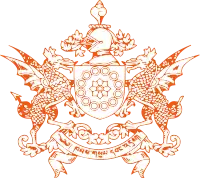 Seal of Sikkim | |
 Palden Thondup Namgyal | |
| Details | |
| First monarch | Phuntsog Namgyal |
| Last monarch | Palden Thondup Namgyal |
| Formation | 1642 |
| Abolition | 16 May 1975 |
| Residence | Gangtok, Sikkim |
| Pretender(s) | Wangchuk Namgyal |
Chogyal kings of Sikkim
History

From 1642 to 1975, Sikkim was ruled by the Namgyal Monarchy (also called the Chogyal Monarchy), founded by the fifth-generation descendants of Guru Tashi, a prince of the Minyak House who came to Sikkim from the Kham district of Tibet.[3] Chogyal means 'righteous ruler', and was the title conferred upon Sikkim's Buddhist kings during the reign of the Namgyal Monarchy.
The reign of the Chogyal was foretold by the patron saint of Sikkim, Guru Rinpoche. The 8th-century saint had predicted the rule of the kings when he arrived in the state. In 1642, Chogyal Phuntsog Namgyal was crowned as Sikkim's first ruler in Yuksom. The crowning of the king was a great event and he was crowned by three revered lamas who arrived there from three different directions, namely the north, west, and south.
List of Chogyals
| No. | Reign | Portrait | Chogyal (Lifespan) |
Events |
|---|---|---|---|---|
| 1 | 1642–1670 |  |
Phuntsog Namgyal (1604–1670) |
Ascended the throne and was consecrated as the first Chogyal of Sikkim. Made the capital at Yuksom in West Sikkim. |
| 2 | 1670–1700 |  |
Tensung Namgyal (1644–1700) |
Shifted capital from Yuksom to Rabdentse which was later destroyed by Gurkhas. |
| 3 | 1700–1717 |  |
Chakdor Namgyal (1686–1717) |
His half-sister Pendiongmu tried to dethrone Chakdor, who fled to Lhasa, but was reinstated as king with the help of Tibetans. |
| 4 | 1717–1733 |  |
Gyurmed Namgyal (1707–1733) |
Sikkim was attacked by Nepalis. |
| 5 | 1733–1780 |  |
Phuntsog Namgyal II (1733–1780) |
Nepalis raided Rabdentse, the then capital of Sikkim. |
| 6 | 1780–1793 |  |
Tenzing Namgyal (1769–1793) |
Chogyal fled to Tibet, and later died there in exile. |
| 7 | 1793–1863 |  |
Tsugphud Namgyal (1785–1863) |
The longest-reigning Chogyal of Sikkim. Shifted the capital from Rabdentse to third capital Tumlong. Treaty of Titalia in 1817 between Sikkim and British India was signed in which territories lost to Nepal were appropriated to Sikkim. Darjeeling was gifted to British India in 1835. Two Britons, Dr. Archibald Campbell and Dr. Joseph Dalton Hooker were captured by the Sikkimese in 1849. Hostilities between British India and Sikkim continued and led to a treaty signed, in which Darjeeling was ceded to the British Raj. |
| 8 | 1863–1874 |  |
Sidkeong Namgyal (1819–1874) |
|
| 9 | 1874–1914 | 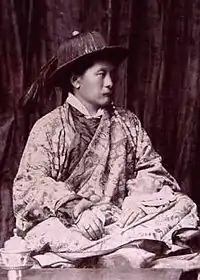 |
Thutob Namgyal (1860–1914) |
John Claude White appointed as the first political officer in Sikkim in 1889. Capital shifted from Tumlong to fourth and last capital at Gangtok in 1894. |
| 10 | 1914 | 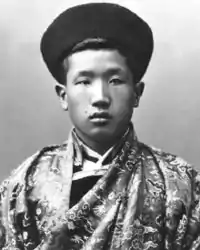 |
Sidkeong Tulku Namgyal (1879–1914) |
The shortest-reigning Chogyal of Sikkim, ruled from 10 February to 5 December 1914. Died of heart failure, aged 35, in most suspicious circumstances. |
| 11 | 1914–1963 | 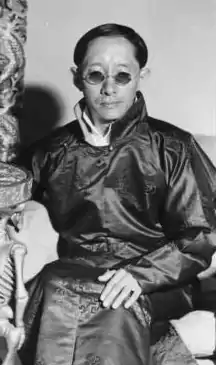 |
Tashi Namgyal (1893–1963) |
Treaty between India and Sikkim was signed in 1950, giving India suzerainty over Sikkim. |
| 12 | 1963–1975 |  |
Palden Thondup Namgyal (1923–1982) |
Crowned on 4 April 1965.[4] The last Chogyal of Sikkim. The country became a state of India, following the 1975 referendum. |
The son from the first marriage of Palden Thondup Namgyal, Wangchuk Namgyal (born 1 April 1953), was named the 13th Chogyal after his father's death on 29 January 1982,[5] but the position no longer confers any official authority.
Royal Flag
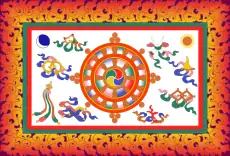 Royal Flag of Sikkim 1877–1975.
Royal Flag of Sikkim 1877–1975.
Chogyal king of Bhutan
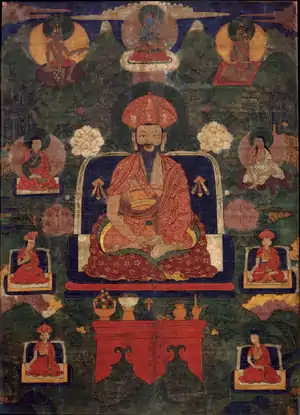
In Bhutan, "dharmaraja" or "Religious King" is a title which was also conferred upon a special class of temporal and spiritual rulers. In Bhutan, the Chogyal were given the respectful title Zhabdrung. In this context, the Chogyal was a recognised reincarnation (or succession of reincarnations) of Shabdrung Ngawang Namgyal, the 17th century Tibetan-born founder of Bhutan. A position of supreme importance, the Bhutanese Chogyal was above both the highest monastic authority, the Je Khenpo, and the highest temporal ruler, the Deb Raja or Druk Desi.[6] There were two main lines of Zhabdrung incarnations in Bhutan.
See also
References
- G. T. (1 March 1975), "Trouble in Sikkim", Index on Censorship, 4: 68–69, doi:10.1080/03064227508532403, S2CID 220927214
- "Sikkim Votes to End Monarchy, Merge With India". The New York Times. 16 April 1975. Retrieved 4 September 2020.
- Measuroo.com States and Territories of India series. Online: (accessed: 14 May 2008)
- "Maharaja and His U.S. Bride Crowned Amid Pomp in Sikkim". The New York Times. 5 April 1965. Retrieved 4 September 2020.
- "Palden Thondup Namgyal, Deposed Sikkim King, Dies". The New York Times. 30 January 1982. Retrieved 4 September 2020.
The deposed King of Sikkim, Palden Thondup Namgyal, who had been undergoing treatment for cancer in New York City, died last night from complications following an operation at Memorial Sloan Kettering Cancer Center. He was 58 years old. A family spokesman said his body was to be flown home to Sikkim for the funeral. ...
- Norbu, Namkhai (1988, 2000). The Crystal and the Way of Light: The Teachings of Namkhai Norbu. (Snow Lion Publications) pg.20 and Notes.